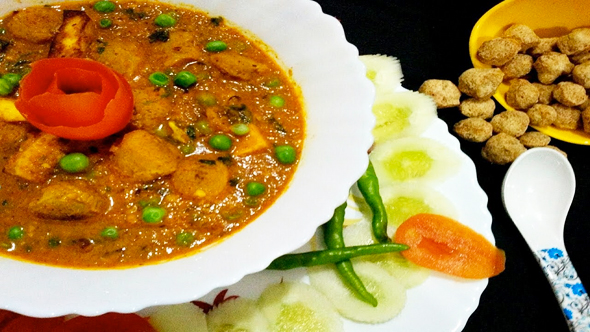Mama’s Punjabi Recipes: Soyabean di Wadiyan te Mutter di Turri (Soyabean Dumpling & Peas Curry)
Talk to a Punjabi about wadiyan (dried dumplings) and he will probably start to have a mental image of a sun-dried lentil dumpling that is full of spices. But a lot has changed in making the traditional wadiyan and along with it, new types of dishes have been developed.
About 25 years ago, small, one-inch cylindrical soyabean wadiyan (dumplings) made of soya powder began showing up in the spice and grocery stores in North India and since then they have become available everywhere. They have become popular because of their reasonable price, spongy texture that absorbs the curry and their health benefits.
Now people are more aware of the protein benefits of soyabean and use these wadiyan in cooking vegetarian dishes.
Soyabean is recognized for its ability to lower cholesterol, LDL and triglycerides, but it does increase HDL. It is also considered beneficial as an antioxidant, minimizing diabetes and reducing inflammation as well as its protein value. Soyabean oil is high in beneficial omega-3 and omega-6 fatty acids and alpha-linolenic acid.
But ultimately, while the traditional Punjabi lentil wadiyan impart their spiciness into the curry in which they simmer, the soyabean wadiyan do the exact opposite: they plump up by soaking up the flavor of the curry. The result is a soft spongy texture that gives a mouthful of juicy flavor with each bite. So, it is important to concentrate on making the curry correctly and not too watery.
Ingredients:
• 2 cups soyabean wadiyan (soyabean lentil dumpling)
• 11/2 cups mutter (peas) – frozen or fresh
• 2 medium pyaaz (onion) – peeled and finely chopped
• 2 medium tamater (tomato) – soft ones are best, chopped
• 5 cloves of lasan (garlic) – peeled and finely chopped
• 1 tbsp adrak (ginger) – peeled and finely chopped
• 2 tbsp of vegetable or olive oil
• 2 cups of pani (water)
• Spices (to taste): namak (salt), mirch (red pepper), haldi (turmeric), dhania (coriander), garam masala
Directions:
1. Place the wadiyan in a small pot of water and bring it to a boil for 10 to 15 minutes.
2. Test a waddi to see if it is soft to chew. If it is, drain the hot water and then immerse the boiled wadiyan in cold water to cool them down.
3. Drain the cold water, then press the wadiyan in your palms to squeeze out the soya smell and all the water.
4. In a medium saucepan prepare the masala in a medium frying pan, heat 2 tablespoons of oil over medium heat, then add the onions, ginger, garlic and tomatoes. Stir well to make sure it doesn’t stick to the bottom. When the mixture is slightly brown, add the namak, mirch, haldi and dhania and stir well.
5. Pour in the wadiyan into the masala, add the peas and stir for 2 minutes.
6. Add the two cups of water, cover the pot and let the water come to a boil. Turn the heat to low and let it simmer for five more minutes to let the flavor soak into the wadiyan.
7. Uncover the pot and check that the wadiyan have become plump and the curry is not too thin and sprinkle with the garam masala. The dish is ready to eat, usually with roti, rice or any variety of bread.
MAMA’S TIP OF THE WEEK
USE OVERCOOKED DAALS OR CURRIES TO MAKE TASTY PARANTHAS
Occasionally you may make a daal or vegetable curry that gets overcooked and ends up turning into a thick stew that is not too tempting to eat. After all, you should be able to distinguish the morsels of food that you eat, especially if it is with roti or bread!
Rather than be tempted to throw the overcooked dish away, keep it off to the side and mix into some wheat flour to make dough. This requires some experience to figure out the best mixture of fluid and flour but when done right, you can make tasty paranthas.

Shakuntla Malhotra is a skilled cook of Punjabi dishes made in the old-fashioned style that she learnt as a young woman in her ancestral home in Lyallpur, India (since renamed Faisalabad) before it became part of Pakistan after the Partition in 1947. People have often admired her cooking for its simplicity and taste that comes with each mouthful. Even in her late-eighties, she continues to cook daily and agreed to share her delectable Punjabi vegetarian recipes for future generations.

